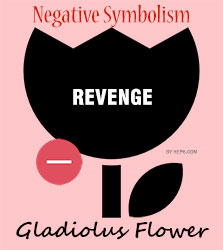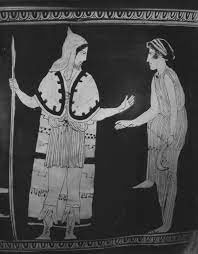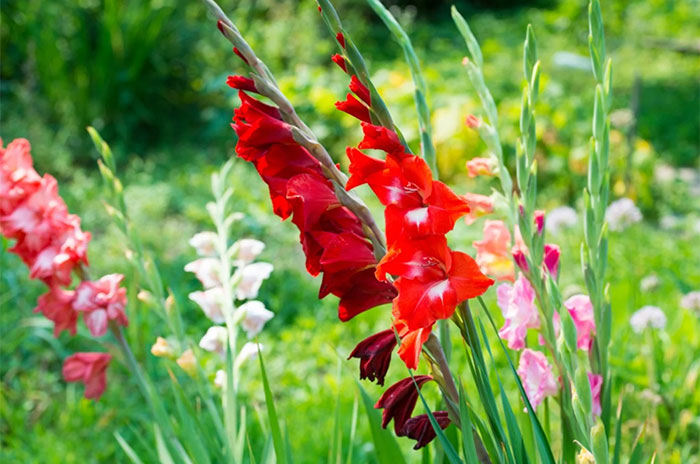Gladiolus Flower Symbolism Facts & Meaning: Zodiac, Superstitions, Dreams, and Legends
I
Gladiolus Flower Facts

Glads, also known as the queen of bulbs, is more commonly known as “sword lily.” The Gladiola plant got its name from the Latin word “gladius,” which means “little sword” because of the shape of its leaves.
The Gladiolus is a genus that can be found in South Africa, Asia, and Mediterranean Europe. It is characterized by its tall flower spikes and sword-like leaves. There are about 300 species and available in several colors.

II
Gladiolus Flower Uses
Gladiolus is commonly popular for bouquets, events ornamentation, and interior decoration. However, it also has the potential for use in health such as in the management of digestive issues and boosting of energy levels.
Moreover, the corm (flowering bulb) is found to help with painful menstruation and rheumatism. The upper root of the Gladiolus stimulates lustful passions, while the lower root of the plant causes barrenness, according to ancient herbalists.

III
Gladiolus Flower History
In the nineteenth century, Europe saw a surge in Gladiola production, with the first interspecific hybrids produced in 1806 and the first commercially available hybrids created in 1823, both in the United Kingdom.
Eventually, in 1837, Gandavensis hybrids were made in Belgium, resulting to the modern Gladiola. The first Gladiola hybrids to gain popularity in the United States were developed in France in the year 1852. Other hybrids were developed in Germany in 1877.
Gladiolus primulinus, discovered near Victoria Falls in 1902, was later used to create light-colored, large-flowered hybrids. Since then, new hybrids have been developed in Europe, the United States, and India.
IV
Gladiolus Flower Positive Symbolism

Red glads represent deep love, white glads means purity, and yellow vibrancy. However, regardless of color, glads generally represent the strength of friendship and integrity drawn from an ancient Greek legend. It tells of the friendship between Svetus and Teresa who have chosen to die together with honor rather than save their own lives.
Ancient Greeks also find the Gladiolus to denote respect and remembrance. Gladiators who win are customarily being showered with Gladiolus Flowers.
V
Gladiolus Flower Negative Symbolism

The only negative symbolism connected to the Gladiolus Flower is the story of Demeter, the Greek goddess of grain and good harvest, also known as Ceres, who once had a sacred grove in Thessaly that she adored.
Despite warnings from Ceres worshipers, an unbeliever named Erisichton took firewood from the sacred grove. He had even severed the head of the man who had warned him of his actions. Ceres was enraged by the act and punished Erisichton with famine, forcing him to sell his daughter. The daughter, however, had escaped to the grove. There, Ceres transformed her into a Gladiolus Flower to keep an eye on the man her father had murdered.
It symbolizes revenge but revenge in a positive way since the goddess took revenge for the blood of the man who was killed, despite only warning the unbeliever to not take firewood from the sacred place.
VI
Gladiolus Flower Cultural Symbolism
Gladiolus, the state flower of Punjab, is one of India’s most beautiful flowers and has been extensively used in various art forms such as dance, music, and poetry. Many poets, including Kalidasa, have referred to it as an emblem of love and devotion. Kalidasa was a Classical Sanskrit author who was widely regarded as ancient India’s greatest poet and playwright. As a result of all of this, Gladiolus was officially designated as the national flower of Punjab, India.
Vishnu, the Hindu god, is associated with the Gladiolus Flower. Vishnu, the preserver of the universe, is frequently depicted holding a conch shell and a discus. The conch shell represents a divine sound, while the discus represents truth.
Both symbols emphasize the significance of remaining connected to our spiritual selves. The Gladiolus Flower reminds us of the importance of connecting to something bigger than ourselves and remaining open to divine possibilities in life.
The hamsa hand mudra is a common meditation and yoga practice gesture. The Hamsa hand represents protection, good fortune, and blessings. We invite positive energy into our lives by placing our hands in this position. The Gladiolus Flower reminds us to stay positive and open-hearted in the face of adversity.
The Gladiolus as a symbol of courage, strength, and determination is evident in many cultures, including Ancient Greece.
In Japan, the Gladiolus stem represents the samurai sword. This was also true in Victorian England when it comes to romantic love.
The Gladiolus can be found on many coins and banknotes issued by countries such as South Africa and Australia.
The flowers are said to represent the four cardinal directions in Native American culture: north, south, east, and west. This suggests that the Gladiolus Flower can assist us in finding our way in life and staying on track. The Gladiolus Flower reminds us to be brave and determined in the face of adversity.
German infantry believed in the magical power of bulbs and wore them as charms during the Middle Ages. The roots of Gladiolus hung as an amulet on the chest of a warrior is believed to save him from death and aid in the victory of the battle.
VII
Gladiolus Flower Zodiac Sign

The flower is connected to the sun god Apollo, who is associated with the August birth flower, commencing the harvest festival that commemorates the goddess Demeter or Ceres, a symbol of fertility and harvest. In relation to zodiac, as a symbol of remembrance, the Gladiolus is an Aquarius
VIII
Gladiolus Flower in Dreams
Dreaming about the Gladiolus is a message from your angels, spirit guides, or deceased loved ones. It may also represent heartbreak and emotional issues. This dream may serve as a reminder that love can be painful at times.
IX
Gladiolus Flower Omens and Superstitions
Gladioli corms were worn as amulets on the chests of medieval landsknechts in Europe, as well as in Ancient Rome because it was believed that they had mystical powers that makes a person invincible and protected from injury. The mesh “armor” – the nerves of the dead cover leaves – was thought to contain the corms’ magical power.
X
Gladiolus Flower Mythology and Folklore

According to legend, Roman general Barbagallo chose Sevtus and Teresa, two of the strongest captured Thracians. Barbagallo trained them as gladiators for arena combat. Instead, Sevtus and Teresa drew their swords and refused to fight. The Roman general then ordered that they be executed. From their blood sprouted a plant with sword-like leaves. The Gladiola is recognized as the flower of gladiators.
In ancient South Africa, when wars were common, legends and beliefs say that invaders came to a small village. The elder went into hiding, protecting the community’s values from enemies. However, they kidnapped and tortured his daughter to find out where the father was hiding. The girl didn’t say anything, so the strangers decided to execute her in front of the entire community. He transformed into a flower with blood-red buds as soon as the sword touched the girl’s neck. The enemies were terrified and decided that the gods had condemned them, so they fled.

